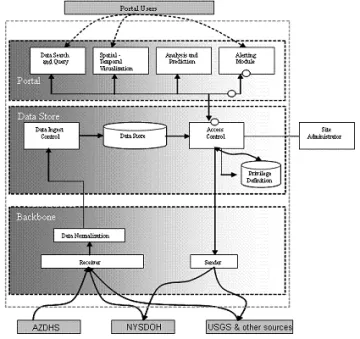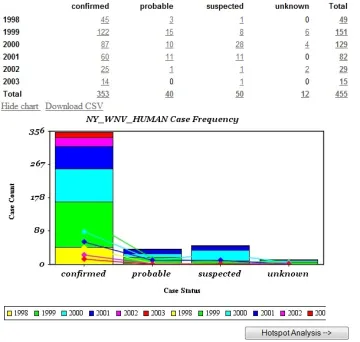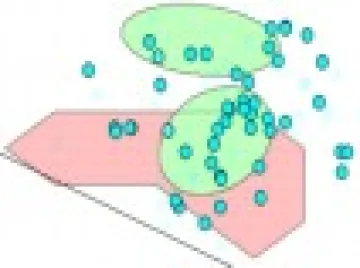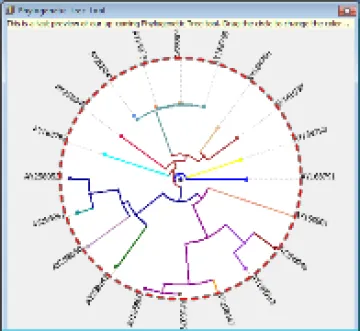Bioportal for Disease Surveillance
Research Goal
Infectious disease outbreaks, either naturally occurring or caused by biological terror attacks, pose a critical threat to public health and national security. Information systems and infectious disease informatics (IDI) research are playing an increasingly important role in developing a comprehensive approach to prevent, detect, respond to, and manage infectious disease outbreaks.
Our research and system development effort is aimed at developing the BioPortal™ system, a cross-jurisdictional, integrated information sharing and data analysis environment. This portal system provides Web-based access to a variety of distributed infectious disease data sources, and readily supports a number of analysis tools including:
- Syndromic surveillance based on hospital emergency department chief complaints as well as other data
- Hot-spot analysis including industry standard algorithms and our innovative clustering-based techniques for retrospective and prospective spatial and temporal data analysis
- Social network analysis to aid in the understanding of the spread of disease
- Data visualization across time and space via our unique Spatio-Temporal Visualizer (STV)
Use of the BioPortal™ system will improve the ability of public health practitioners to detect, and maintain situational awareness of outbreaks of emerging diseases and bioterrorist attacks, allowing for more timely and efficient deployment of resources for further investigation and response measures. This system could also enable hospital administrators to better track infections and improve infection.
For more information, see these important publications:
- H. Chen, D. Zeng, and P. Yan. INFECTIOUS DISEASE INFORMATICS: SYNDROMIC SURVEILLANCE FOR PUBLIC HEALTH AND BIODEFENSE, Springer, 2010.
- D. Zeng, H. Chen, C. Castillo-Chavez, W.B. Lober, and M. Thurmond, eds. INFECTIOUS DISEASE INFORMATICS AND BIOSURVEILLANCE, Integrated Series in Information Systems, vol. 27. Springer, 2011.
Funding (selected)
- National Science Foundation Information Technology Research Program, ITR, Grant # IIS-0428241, October 2005 - September 2009, $1,200,000
- United States Department of Agriculture, FMD BioPortal, USDA Grant # 2006-39546-17579, September 2006 – January 2008. $270,000
- Enhancing and Extending RSVP-A based on the BioPortal Framework, Kansas State University, July 2005 - December 2006, $250,000
- Arizona Department of Health Services, Syndromic Surveillance for the State of Arizona, December 2005 - November 2006, $250,000
- National Science Foundation Digital Government Program through Grant #EIA-9983304, October 2003 - March, 2004, $800,000
Research Partners
- The New York State Department of Health
- Dr. Millicent Eidson
- Dr. Ivan Gotham
- The California Department of Health Services
- Dr. Mike Ascher
- The Foot and Mouth Disease Laboratory at the University of California at Davis
- Dr. Mark Thurmond
- Dr. Andres Perez
- The Arizona State Department of Health Services
- Ken Komatsu, M.P.H.
- Dr. Lea Trujillo
- The University of Utah
- Dr. Paul Hu
- Kansas State University - College of Veterinary Medicine
- Dr. Mary Vanier
- Dr. Brad de Groot
- OntoReason, LLC
- Dr. Cecil Lynch
- The SimiGroup
- Dan Desmond
- The National Wildlife Health Center
- Joshua Dein MD
- Beijing Centers for Disease Control and Prevention & Centers for Preventive Medical Research
- Dr. Quanyi Wang
- National Taiwan University
- Dr. Chwan-Chuen King
- Kvach Consulting
- Dr. James Kvach
Team Members
| Dr. Hsinchun Chen | hchen@eller.arizona.edu | |||||||||||||
| Dr. Daniel Zeng | zeng@eller.arizona.edu | |||||||||||||
| Cathy Larson | ||||||||||||||
| Christopher MacPhee | ||||||||||||||
| Yi-Da Chen (Allen) | ||||||||||||||
| Hsin-Min Lu | ||||||||||||||
| Aaron Sun | ||||||||||||||
| Ping Yan | ||||||||||||||
| Yulei Zhang (Gavin) | ||||||||||||||
| Project Collaborators | ||||||||||||||
| Dr. Paul Hu | University of Utah | |||||||||||||
| Dr. Mark Thurmond | University of California-Davis | |||||||||||||
| Dr. Cecil Lynch | OntoReason, LLC | |||||||||||||
| Dr. Mike Ascher | Lawrence Livermore National Laboratory | |||||||||||||
| Ken Komatsu, M.P.H. | Arizona Department of Health Services | |||||||||||||
| Lea Trujillo, Ph.D. | Arizona Department of Health Services | |||||||||||||
| Dr. James Kvach | Kvach Consulting | |||||||||||||
| Dr. Quanyi Wang | Beijing Centers for Disease Control and Prevention | |||||||||||||
| Dr. Chwan-Chuen King | National Taiwan University | |||||||||||||
| Dr. Millicent Edison | New York State Department of Health | |||||||||||||
| Dr. Ivan Gotham | New York State Department of Health | |||||||||||||
| Dr. Mary Vanier | Kansas State University | |||||||||||||
| Dr. Brad de Groot | Kansas State University | |||||||||||||
| Joshua Dein, MD | National Wildlife Health Center | |||||||||||||
|
System Architecture

The BioPortal System is loosely-coupled with its data providers, in that the providers transmit infectious disease data through secure links to the portal system using mutually-agreed protocols. Such information, in turn, is stored in the internal data store maintained by BioPortal. The system also automatically retrieves data items from its sources and stores them in the internal data store. The Web portal component implements the user interface and provides data access, analysis, and visualization functionalities.
System Features
BioPortal™ can be used en-suite as a powerful BioSurveillance tool. Its flexible modules can also be licensed for use in a variety of data analysis applications.
Surveillance Portal

The Surveillance Portal is an interactive web-based application that allows the user to explore the incidence of infectious diseases. The portal allows the
- Select a disease of concern and access related databases
- Narrow the scope by time-frame and geographic area of interest
- View a variety of data aggregations
- Perform Hotspot Analysis to focus attention on critical areas
Spatial-Temporal Visualizer

The STV module allows the visualization of disease outbreaks in both time and space. The module comes complete with a rich set of tools to aid the user in analyzing the outbreak, including a time line tool, various charting tools, and a highly customizable map.
- Zoom in to view a specific region, or zoom out to get a strategic view
- Adjust the visible time window
- View the progress of the incidence of disease through the affected area and over the selected time span
Hotspot Analysis

Hotspot Analysis is used to identify clusters of related events (hotspots) based on historical spatial-temporal data. One of our key innovations is the application of the advanced Risk-adjusted Support Vector Clustering and Prospective Support Vector Clustering hotspot analysis algorithms to allow for the discovery of non-circular hotspots. Other well-established techniques - SaTScan and the Risk-adjusted Nearest Neighborhood algorithm - are also made available as part of the BioPortal System.
Phylogenetic Tree Analysis

Phylogenetic Tree Analysis examines the DNA of pathogens to determine the genetic relationship between various strains, and to identify possible sources or mutation. The module:
- Color-codes outbreak occurrences based on distance in genetic space
- Helps predict distribution of virus strains
- Aids in more efficient vaccine distribution
Chief Complaint Classifier (Multilingual)
The Chief Complaint Classifier Module of the BioPortal System maps Chief Complaint (CC) records generated by hospital emergency departments to syndromic categories. This mapping is a three step process:
- In the first stage CCs are standardized and mapped to Unified Medical Language System concepts.
- In the second stage, each symptom is mapped into an appropriate symptom group to enable system modularity, extensibility, and flexibility
- In the last stage, the system uses the JESS rule inference engine to decide to which syndrome the CC belongs. This is done by mapping the symptom groups obtained from stage two to predefined syndromic categories
This process allows for the systematic collection, analysis, and interpretation of data that may act as early indicators for epidemics independent of an explicit doctor's diagnosis of disease. The CC Classifier is also available for Chinese records and can be easily adapted for other languages.
Social Network Analysis (SNA)

Examining social networks is a valuable epidemiological tool for understanding the progression of the spread of an infectious disease. In a biosurveillance context, including geographical contacts in the analytical framework provides much higher connectivity in network construction than using personal contacts alone. The Social Network Analysis module in the BioPortal system incorporates geographical locations, such as high risk areas and hospitals, into social networks to provide insights into the role of such locations in disease transmission, and identify potential bridges between locations. This helps to maintain situational awareness and focus incident investigation and mitigation efforts. The SNA module has been adopted for analysis of the SARS outbreak in Taiwan.
Publications
Edited Books
- Zeng, D., Gotham, I., Komatsu, K., Lynch, C., Thurmond, M., Madigan, D., Lober, B., Kvach, J., and Chen, H. (eds.) (2007). “Intelligence and Security Informatics: Biosurveillance,” NSF Biosurveillance Workshop: Systems and Case Studies, BioSurveillance 2007 Proceedings, Springer, Lecture Notes in Computer Science, No. 4506.
- Yang, C., Zeng, D., Chau, M., Chang, K., Yang, Q., Cheng, X., Wang, J., Wang, F.-Y., and Chen, H. (eds.) (2007). “Intelligence and Security Informatics,” Pacific Asia Workshop, PAISI 2007 Proceedings, Springer, Lecture Notes in Computer Science, No. 4430.
- Mehrotra, S., Zeng, D., Chen, H., Thuraisingham, B., and Wang, F.-Y. (eds.) (2006). “Intelligence and Security Informatics,” IEEE International Conference on Intelligence and Security Informatics, ISI 2006 Proceedings, Springer, Lecture Notes in Computer Science, No. 3975.
- Chen, H., Raghu, T.S., Ramesh, R., Vinze, A., and Zeng, D. (eds.) (2007). “Handbooks in Information Systems: National Security,” Elsevier.
- Chen, H., Wang, F.-Y., Yang, C., Zeng, D., Chau, M., and Chang, K. (eds.) (2006). “Intelligence and Security Informatics,” International Workshop, WISI 2006 Proceedings, Springer, Lecture Notes in Computer Science, No. 3917.
- Kantor, P., Muresan, G., Roberts, F., Zeng, D., Wang, F.-Y., Chen, H., and Merkle, R. (eds.) (2005). “Intelligence and Security Informatics,” IEEE International Conference on Intelligence and Security Informatics, ISI 2005 Proceedings, Springer, Lecture Notes in Computer Science, No. 3495.
Journal Articles
- D. Zeng, H. Chen, and C. Lynch, “BioPortal: Sharing, Analyzing, and Visualizing Infectious Disease Information,” Communications of the ACM, forthcoming, 2012.
- Y. Chen, S. Brown, P. J. Hu, and H. Chen, “Managing Emerging Infectious Diseases with Information Systems: Reconceptualizing Outbreak Management through the Lens of Loose Coupling,” Information Systems Research, Volume 22, Number 3, Pages 447-468, September 2011.
- A. Sun, D. Zeng, and H. Chen, “Burst Detection from Multiple Data Streams: A Network Based Approach,” IEEE Transactions on Systems, Man, and Cybernetics, Part C, Volume 40, Number 3, Pages 258-267, 2010.
- H. Lu, D. Zeng, and H. Chen, “Prospective Infectious Disease Outbreak Detection Using Markov Switching Models,” IEEE Transactions on Knowledge and Data Engineering, Volume 22, Number 4, Pages 565-577, 2010.
- H. Chen and D. Zeng, “AI for Global Disease Surveillance,” IEEE Intelligent Systems, Volume 24, Number 6, Pages 66-69, November/December, 2009.
- D. Zeng, H. Chen, Z. Cao, F. Wang, X. Zheng, and Q. Wang, “Disease Surveillance Based on Spatial Contact Networks: A Case Study of Beijing 2003 SARS Epidemic,” IEEE Intelligent Systems, Volume 24, Number 6, Pages 77-82, November/December, 2009.
- Y. Zhang, Y. Dang, H. Chen, M. Thurmond, and C. Larson, “Automatic Online News Monitoring and Classification for Syndromic Surveillance,” Decision Support Systems, Volume 47, Number 4, Pages 508-517, 2009.
- H.-M. Lu, D. Zeng, and H. Chen, "Multilingual Chief Complaint Classification for Syndromic Surveillance: An Experiment with Chinese Chief Complaints," International Journal of Medical Informatics, Volume 78, Number 5, Pages 308-320, 2009.
- A. M. Perez, D. Zeng, C. Tseng, H. Chen, Z. Whedbee, D. Paton, and M. C. Thurmond, “A Web-based System for Near Real-time Surveillance and Space-time Cluster Analysis of Foot-and-mouth Disease and Other Animal Diseases,” Preventive Veterinary Medicine, Volume 91, Number 1, Pages 39-45, 2009.
- Y. Dang, Y. Zhang, H. Chen, P. J. Hu, S. Brown, and C. Larson, “Arizona Literature Mapper: An Integrated Approach to Monitor and Analyze Global Bioterrorism Research Literature,” Journal of the American Society for Information Science and Technology, Volume 60, Number 7, Pages 1466-1485, 2009.
- Zeng, D., Chen, H., and Lynch, C. “BioPortal: Sharing, Analyzing, and Visualizing Infectious Disease Information,” Communications of the ACM, forthcoming, 2007.
- Lu, H.-M., Zeng, D., Trujillo, L., Komatsu, K., and Chen, H. (2007). “Ontology-enhanced Automatic Chief Complaint Classification for Syndromic Surveillance,” accepted for publication in Journal of Biomedical Informatics.
- Yan, P., Chen, H., and Zeng, D. (2007). “Syndromic Surveillance Systems: Public Health and Biodefence,” Annual Review of Information Science and Technology (ARIST), Vol. 41, pp. 425-495.
- Hu, P.-J.H., Zeng, D., Chen, H., Larson, C., Chang, W., Tseng, C., and Ma, J. (2007). “System for Infectious Disease Information Sharing and Analysis: Design and Evaluation,” IEEE Transactions on Information Technology in Biomedicine, Vol. 11, No. 4, pp. 483–492, July.
- Zeng, D., Dai, R.-W., Wang, F.-Y., Mao, W., and Wang, Q.-Y., “Infectious Disease Informatics and Syndromic Surveillance,” Science and Technology Review (Chinese).
- Chang, W., Zeng, D., and Chen, H. “A Spatio-Temporal Data Analysis Approach based on Prospective Support Vector Clustering,” under revision for Decision Support Systems.
Book Chapters
- Thurmond, M., Perez, A., Tseng, C., Chen, H., and Zeng, D. (2007) “Global Foot-and-Mouth Disease Surveillance using BioPortal,” in Intelligence and Security Informatics: BioSurveillance, edited by Zeng, D., Gotham, I., Komatsu, K., Lynch, C., Thurmond, M., Madigan, D., Lober, B., Kvach, J., and Chen, H., Springer Lecture Notes in Computer Science, No. 4506.
- Lu, H.-M., King, C.-C., Wu, T.S., Shin, F.-Y., Hsiao, J.-Y., Zeng, D., and Chen, H. (2007). “Chinese Chief Complaint Classification for Syndromic Surveillance,” in Intelligence and Security Informatics: BioSurveillance, edited by Zeng, D., Gotham, I., Komatsu, K., Lynch, C., Thurmond, M., Madigan, D., Lober, B., Kvach, J., and Chen, H., Springer Lecture Notes in Computer Science, No. 4506.
- Hu, P., Zeng, D., Chen, H., Larson, C., Tseng, C. (2007). “A Web-based System for Infectious Disease Data Integration and Sharing: Evaluating Outcome, Task Performance Efficiency, User Information Satisfaction, and Usability,” in Intelligence and Security Informatics: BioSurveillance, edited by Zeng, D., Gotham, I., Komatsu, K., Lynch, C., Thurmond, M., Madigan, D., Lober, B., Kvach, J., and Chen, H., Springer Lecture Notes in Computer Science, No. 4506.
- Zeng, D., Chen, H., and Yan, P. (2007). “Infectious Disease Informatics and Syndromic Surveillance,” in Digital Government, Chapter 26, Springer.
- Zeng, D., Chen, H., and Chang, W. (2007). “Spatio-Temporal Data Analysis in Security Informatics,” in Handbooks in Information Systems: National Security, Elsevier, edited by H. Chen, T.S. Raghu, R. Ramesh, A. Vinze, and D. Zeng, in press.
- Ma, J., Zeng, D., and Chen, H. (2006). “Spatial-Temporal Cross-Correlation Analysis: A New Measure and A Case Study in Infectious Disease Informatics,” in Intelligence and Security Informatics, Proceedings of the IEEE International Conference on Intelligence and Security Informatics (ISI-2006), edited by Sharad Mehrotra, Daniel Zeng, Hsinchun Chen, Bhavani Thuraisingham, and Fei-Yue Wang, Springer Lecture Notes in Computer Science, Vol. 3975.
- Yan, P., Zeng, D., and Chen, H. (2006). “A Review of Public Health Syndromic Surveillance Systems,” in Intelligence and Security Informatics, Proceedings of the IEEE International Conference on Intelligence and Security Informatics (ISI-2006), edited by Sharad Mehrotra, Daniel Zeng, Hsinchun Chen, Bhavani Thuraisingham, and Fei-Yue Wang, Springer Lecture Notes in Computer Science, Vol. 3975.
- Hu, P., Zeng, D., Chen, H., Larson, C., Chang, W., and Tseng, L. (2005). “Evaluating an Infectious Disease Information Sharing and Analysis Systems,” in Intelligence and Security Informatics, Proceedings of the IEEE International Conference on Intelligence and Security Informatics (ISI-2005), edited by Paul Kantor, Gheorghe Muresan, Fred Roberts, Daniel Zeng, Fei-Yue Wang, Hsinchun Chen, and Ralph Merkle, Springer Lecture Notes in Computer Science, Vol. 3495.
- Zeng, D., Chen, H., Eidson, M., Gotham, I., and Lynch, C. (2005). “Disease Informatics and Outbreak Detection,” Chapter 13, in Advances in Medical Informatics: Knowledge Management and Data Mining in Biomedicine, edited by Hsinchun Chen, Sherrilynne Fuller, and Alexa McCray, Springer-Verlag.
- Zeng, D., Chen, H., Tseng, L., Larson, C., Eidson, M., Gotham, I., Lynch, C., and Ascher, M. (2004). “West Nile Virus and Botulism Portal: A Case Study in Infectious Disease Informatics,” in Intelligence and Security Informatics, Proceedings of ISI-2004, Lecture Notes in Computer Science, pp. 28–41, Vol. 3073, Chen, H., Moore, R., Zeng, D., and Leavitt, J. (eds), Springer.
- Lu, H.-M., Zeng, D., and Chen, H. (2006). “Ontology-based Automatic Chief Complaints Classification for Syndromic Surveillance,” Proceedings of the 2006 IEEE International Conference on Systems, Man, and Cybernetics, IEEE Press, Taipei, Taiwan, October.
- Sun R., Zeng, D., and Yan, P. (2006). “A Network-based Burst Detection Method in Data Streams,” Proceedings of the Fifth Workshop on e-Business (WeB 2006), Milwaukee, Wisconsin, December.
Refereed Conference Publications
- Ku, Y., Chiu, C., Zhang, Y., Fan, L., and Chen, H., “Global Disease Surveillance using Social Media: HIV/AIDS Content Intervention in Web Forums,” Proceedings of 2010 IEEE International Conference on Intelligence and Security Informatics, ISI 2010, Vancouver, Canada, May 2010.
- Chen, H., “Discovery of Improvised Explosive Device Content in the Dark Web,” Proceedings of 2008 IEEE International Conference on Intelligence and Security Informatics, ISI 2008, Taipei, Taiwan, June 2008.
- Lu, H., Zeng, D., and Chen, H., “Bioterrorism Event Detection Based on the Markov Switching Model: A Simulated Anthrax Outbreak Study,” Proceedings of 2008 IEEE International Conference on Intelligence and Security Informatics, ISI 2008, Taipei, Taiwan, June 2008.
- Chen, Y., Tseng, C., King, C.C., Wu, T., and Chen, H., “Incorporating Geographical Contacts into Social Network Analysis for Contact Tracing in Epidemiology: A Study on Taiwan SARS Data,” Intelligence and Security Informatics: Biosurveillance, Proceedings of the Second Workshop, BioSurveillance 2007, New Brunswick, NJ, May 2007, Lecture Notes in Computer Science (LNCS 4506), Springer-Verlag.
- Lu, H., Zeng, D., and Chen, H., “Medical Ontology-enhanced Text Processing for Infectious Disease Informatics,” Proceedings of 2007 IEEE Intelligence and Security Informatics, ISI 2007, New Brunswick, NJ, May 2007.
- Chen, H., Zeng, D., Tseng, C., Larson, C., Eidson, M., Gotham, I., Lynch, C., and Hu, P., “A National Center of Excellence for Infectious Disease Informatics,” Proceedings of the 6th National Conference on Digital Government Research, DG.O 2005, Atlanta, Georgia, May 2005.
- Zeng,D., Chen, H., Tseng, C., Larson, C., Eidson, M., Gotham, I., Lynch, C., and Ascher, M., “BioPortal: An Integrated Infectious Disease Information Sharing and Analysis Environment,” Proceedings of the 6th National Conference on Digital Government Research, DG.O 2005, Atlanta, Georgia, May 2005.
- Chen, H., “Biomedical Informatics and Security Informatics Research in Digital Library,” Proceedings of the 7th International Conference on Asian Digital Libraries, ICADL 2004, Shanghai, China, December 2004, Lecture Notes in Computer Science (LNCS 3334), Springer-Verlag.
- Zeng, D., Chang, W., and Chen, H., “A Comparative Analysis of Spatio-Temporal Hotspot Analysis Techniques in Security Informatics,” Proceedings of the 7th IEEE International Conference on Intelligent Transportation Systems (ITSC 2004), Washington, DC, October 3-6, 2004.
- Atabakhsh, H., Larson, C., Petersen, T., Violette, C., and Chen, H., “Information Sharing and Collaboration Policies within Government Agencies,” Intelligence and Security Informatics, Proceedings of the Second Symposium on Intelligence and Security Informatics, ISI 2004, Tucson, Arizona, June 2004, Lecture Notes in Computer Science (LNCS 3073), Springer-Verlag.
- Zhou, Y., Qin, J., and Chen, H., “CMedPort: Intelligent Searching for Chinese Medical Information,” Proceedings of the 6th International Conference on Asian Digital Libraries, ICADL 2003, Kuala Lumpur, Malaysia, December 2003, Lecture Notes in Computer Science (LNCS 2911), Springer-Verlag.
- Zeng, D., Chen, H., Tseng, C., Larson, C., Eidson, M., Gotham, I., Lynch, C., and Ascher, M., “Towards a National Infectious Disease Information Infrastructure: A Case Study in West Nile Virus and Botulism,” Proceedings of the National Conference on Digital Government Research, DG.O 2004, Seattle, Washington, May 2004, Digital Government Research Center.
- Zhou, Y., Qin, J., and Chen, H., “CMedPort: Intelligent Searching for Chinese Medical Information,” Proceedings of the 6th International Conference on Asian Digital Libraries, ICADL 2003, Kuala Lumpur, Malaysia, December 2003, Lecture Notes in Computer Science (LNCS 2911), Springer-Verlag.

